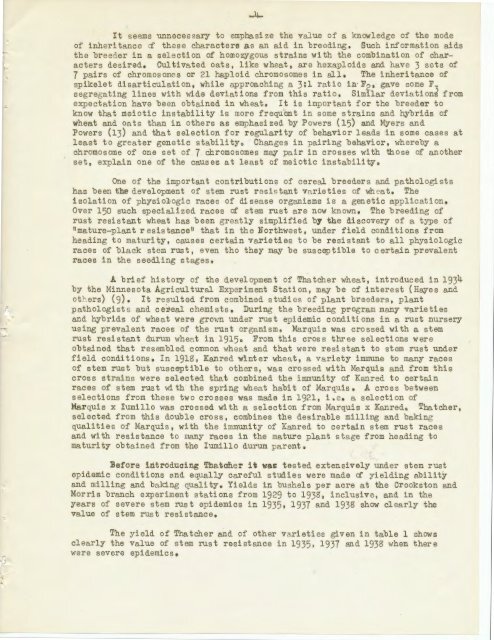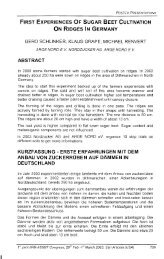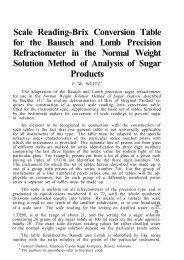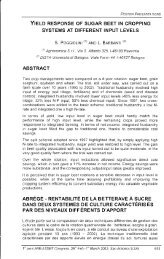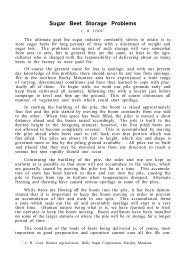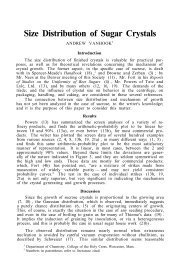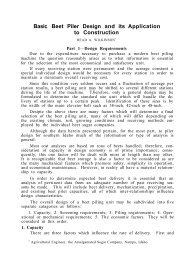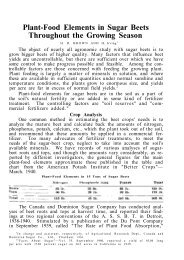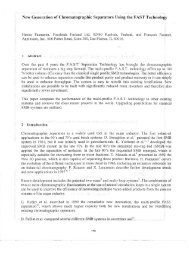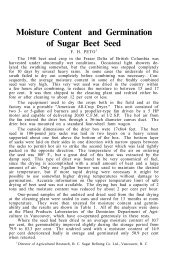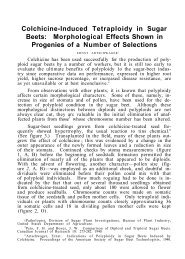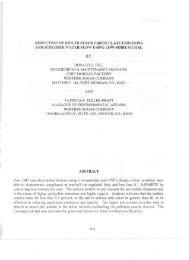Some illustrations of methods in plant breeding - ASSBT Proceedings
Some illustrations of methods in plant breeding - ASSBT Proceedings
Some illustrations of methods in plant breeding - ASSBT Proceedings
You also want an ePaper? Increase the reach of your titles
YUMPU automatically turns print PDFs into web optimized ePapers that Google loves.
-4-<br />
It seems unneces sary to empha size the value <strong>of</strong> a kn011rledge <strong>of</strong> the mode<br />
<strong>of</strong> <strong>in</strong>heritance <strong>of</strong> these characters ,as an aid <strong>in</strong> breed<strong>in</strong>g. Such <strong>in</strong>formation aids<br />
the breeder <strong>in</strong> a selection <strong>of</strong> homozygous stra<strong>in</strong>s with the comb<strong>in</strong>ation <strong>of</strong> characters<br />
desired. Cultivated oats, like wheat, are hexaploids and have 3 sets <strong>of</strong><br />
7 pairs <strong>of</strong> chromosomes or 21 haploid chromosomes <strong>in</strong> all. The <strong>in</strong>heritance <strong>of</strong><br />
spikelet disarticulation, while approach<strong>in</strong>g a 3:1 ratio <strong>in</strong>, F2 , gave some F<br />
segregat<strong>in</strong>g l<strong>in</strong>es with wide deviations from this ratio. Similar deviation~ from<br />
expectation have been obta<strong>in</strong>ed <strong>in</strong> wheat. It is important for the breeder to<br />
know that meiotic <strong>in</strong>stability is more frequent <strong>in</strong> some stra<strong>in</strong>s and hybrids <strong>of</strong><br />
wheat and oats than <strong>in</strong> others as emphasized by Powers ( 15) and Myers and<br />
Po1-rers (13) and that selection for regularity <strong>of</strong> behavior leads <strong>in</strong> some cases at<br />
least to greater genetic stabilityo Changes <strong>in</strong> pair<strong>in</strong>g behavior, whereby a<br />
chromosome <strong>of</strong> one set <strong>of</strong> 7 chromosomes may pair <strong>in</strong> crosses with those <strong>of</strong> another<br />
set, expla<strong>in</strong> one <strong>of</strong> the causes at least <strong>of</strong> meiotic <strong>in</strong>stability.<br />
One <strong>of</strong> the important contributions <strong>of</strong> cereal breeders and pathologists<br />
has been t'he development <strong>of</strong> stem rust resh tant varieties <strong>of</strong> wh eat. The<br />
isolation <strong>of</strong> physiollogic races <strong>of</strong> disease organisms is a genetic application.<br />
Over 150 such specialized races <strong>of</strong> stem rust are no,., known. The breed<strong>in</strong>g <strong>of</strong><br />
rust resistant wheat has been greatly simplified by the discovery <strong>of</strong> a type <strong>of</strong><br />
11 mature-<strong>plant</strong> r esis tancell that <strong>in</strong> the Northwest, under field conditions from<br />
head<strong>in</strong>g to maturity, causes certa<strong>in</strong> varieties to be resistant to all physiologic<br />
races <strong>of</strong> black stem rust, even tho they may be susceptible to certa<strong>in</strong> prevalent<br />
races <strong>in</strong> the seedl<strong>in</strong>g stages.<br />
A brief history <strong>of</strong> the d,evelopment <strong>of</strong> Thatcher wheat, <strong>in</strong>troduced <strong>in</strong> 1934<br />
by the M<strong>in</strong>nesota Agricultural Experiment Station, may 'be <strong>of</strong> <strong>in</strong>terest (Hayes and<br />
ot0ers) (9). It resulted from comb<strong>in</strong>ed studies <strong>of</strong> <strong>plant</strong> breeders, <strong>plant</strong><br />
pathologists and ce~eal chemists. Dur<strong>in</strong>g the breed<strong>in</strong>g program many varieties<br />
and hybrids <strong>of</strong> wheat 1vere grovm under rust epidemic conditions <strong>in</strong> a rust nursery<br />
us<strong>in</strong>g prevalent races <strong>of</strong> the rust organism~ Marquis was crossed with a stem<br />
rust resistant durum 1.vhen.t <strong>in</strong> 1915c From this cross three selections were<br />
obta<strong>in</strong>ed that resembled common wh Gat and that were resistant to stem rust under<br />
field, conditions. In 1918, Kanred ':~<strong>in</strong>ter wheat, a variety immune to many races<br />
<strong>of</strong> stem rust but susceptible to others, was crossed. with Harq_uis and from this<br />
cross stra<strong>in</strong>s were selected that comb<strong>in</strong>ed the immunity <strong>of</strong> Kanred to certa<strong>in</strong><br />
races <strong>of</strong> stem rust "ri th the spr<strong>in</strong>g wheat habit <strong>of</strong> Marquis • A cross between<br />
selections from these two crosses was made <strong>in</strong> 1921, i.e. a selection <strong>of</strong><br />
Marquis x Iumillo was crossed with a selection from ~~rq~is x Kanredo Thatcher,<br />
selected from this double cross, comb<strong>in</strong>es the desirable mill<strong>in</strong>g and bak<strong>in</strong>g<br />
~ualities <strong>of</strong> Mar~uis, with the immunity <strong>of</strong> Kanred to certa<strong>in</strong> stem rust races<br />
and with resistance to rnany races <strong>in</strong> the mature <strong>plant</strong> stage from head<strong>in</strong>g to<br />
maturity obta<strong>in</strong>ed from the Iumillo durum parent.<br />
l3efore <strong>in</strong>troduc<strong>in</strong>g Tha.toher it was tested extensively under stem rust<br />
epidemic conditions a.nd equally careful studies were made <strong>of</strong> yield<strong>in</strong>g e:bility<br />
and mill<strong>in</strong>g and bo,k:<strong>in</strong>g q_uali ty. Yields <strong>in</strong> bushels per acre at the Crookston and<br />
Morris branch experiment stations from 1929 to 1938 1 <strong>in</strong>clusive, and <strong>in</strong> the<br />
years <strong>of</strong> severe stem rust epidemics <strong>in</strong> 1935, 1937 and 1938 show clearly the<br />
value <strong>of</strong> stem rust resistance.<br />
The yield <strong>of</strong> Thatcher and <strong>of</strong> other varieties given <strong>in</strong> table 1 shO\-JS<br />
clearly the value <strong>of</strong> stem rust resistance <strong>in</strong> 1935, 1937 and 1938 ,.,hen there<br />
were severe epidemics •


